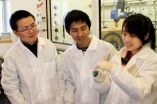With the aim of being up to fifty per cent lighter than conventional chemical battery packs used by British infantry, the solar and thermoelectric-powered system could make an important contribution to future military operations.
The project is being developed by the University of Glasgow with Loughborough, Strathclyde, Leeds, Reading and Brunel Universities, with funding from the Engineering and Physical Sciences Research Council (EPSRC). It is also supported by the Defence Science and Technology Laboratory (Dstl).
The system's innovative combination of solar photovoltaic (PV) cells*, thermoelectric devices** and leading-edge energy storage technology will provide a reliable power supply round-the-clock, just like a normal battery pack. The team is also investigating ways of managing, storing and utilising heat produced by the system.
Because it is much lighter, the system will improve soldiers' mobility. Moreover, by eliminating the need to return to base regularly to recharge batteries, it will increase the potential range and duration of infantry operations. It will also absorb energy across the electromagnetic spectrum, making infantry less liable to detection by night vision equipment that uses infra-red technology, for instance.
Minister for Universities and Science David Willetts said: "The armed forces often need to carry around a huge amount of kit and the means to power it. It's great that specialists from a range of science disciplines are coming together to develop lighter, more reliable technology that will help to make life easier for them in the field."
Although substantial research into solar power for soldiers has already been conducted worldwide, this new UK project differs in its use of thermoelectric devices to complement solar cells, delivering genuine 24/7 power generation capability. The project team is also investigating how both types of device could actually be woven into soldiers' battle dress, which has never been done before***.
During the day, the solar cells will produce electricity to power equipment. During the night, the thermoelectric devices will take over and perform the same function. The system will also incorporate advanced energy storage devices to ensure electricity is always available on a continuous basis.
"Infantry need electricity for weapons, radios, global positioning systems and many other vital pieces of equipment," says Professor Duncan Gregory of the University of Glasgow. "Batteries can account for over ten per cent of the 45-70kg of equipment that infantry currently carry. By aiding efficiency and comfort, the new system could play a valuable role in ensuring the effectiveness of army operations."
PV cells, thermoelectric devices and advanced energy storage devices are already widely used in a range of applications. A key aim of the project team, however, is to produce robust, hard-wearing designs specifically for military use in tough, hostile conditions.
Because it will harness clean, free energy sources, the new power system will also offer significant environmental advantages compared with the conventional battery packs currently used by the British army.
To tackle the many challenges that the project presents, the team includes specialists from a wide range of disciplines including chemistry, materials science, process engineering, electrical engineering and design. Feedback from serving soldiers will also play a crucial role in optimising the power system for front-line use.
"We aim to produce a prototype system within two years," says Professor Gregory. "We also anticipate that the technology that we develop could be adapted for other and very varied uses. One possibility is in niche space applications for powering satellites, another could be to provide means to transport medicines or supplies at cool temperatures in disaster areas or to supply fresh food in difficult economic or climatic conditions".
INFORMATION:
Notes for Editors
'The Solar Soldier' is a 2-year project due to be completed in December 2011.
The project will receive total EPSRC and MOD funding of just over £650,000. In addition, the University of Leeds and Brunel University are also providing funding, and communications and avionics electronics company Rockwell-Collins are supporting a studentship which will contribute to the project.
* PV cells generate electricity directly from sunlight.
** Thermoelectric devices harness the 'Seebeck Effect' (named after the scientist who discovered it in 1821) whereby a voltage is created in the presence of a temperature difference between two metals or two semiconductors. Thermoelectric devices are already used in the automotive industry and in space probes, for example. In the application being investigated by this project, the devices would generate power by using the difference in temperature between the outside and the inside of a soldier's battle dress.
*** The team's objectives are (i) to produce nanostructured PV and thermoelectric films on conventional rigid substrates (i.e. underlying layers) separately and then together, and (ii) to repeat the process using flexible substrates. The resulting flexible hybrid power generation devices would be unique and could even be coloured to camouflage them.
About EPSRC
EPSRC is the main UK government agency for funding research and training in engineering and the physical sciences, investing more than £850 million a year in a broad range of subjects – from mathematics to materials science, and from information technology to structural engineering. www.epsrc.ac.uk
About Dstl
The Defence Science and Technology Laboratory (Dstl) is an agency of the Ministry of Defence (MOD) and exists to supply the very best, impartial, scientific and technical research and advice to the MOD and other government departments. www.dstl.gov.uk
For more information about the partner universities please use the following links:
University of Glasgow, Loughborough University, University of Strathclyde, University of Leeds, University of Reading, Brunel University
For more information contact:
Professor Duncan Gregory, Department of Chemistry, University of Glasgow, tel: 0141 330 6438, e-mail: d.gregory@chem.gla.ac.uk
Images are available from the EPSRC Press Office. Contact: 01793 444404, or e-mail: pressoffice@epsrc.ac.uk
Images information and suggested captions:
Wires.jpg: 'Military power – micrograph of the thermoelectric nanowires'.
Soldier1,2,3 and 4.jpgs: 'soldier in a fictitious but realistic urban, desert environment, the superimposed numbers are readings for anticipated sunlight.
END




